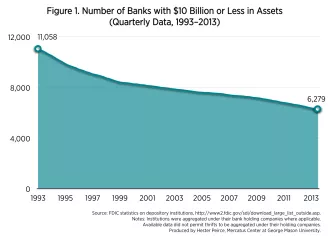In a competitive market with free entry, bank size doesn't really matter, but regulations can distort firm size. At a recent Senate Banking Committee hearing on Federal Reserve reforms, Professor Allan Meltzer suggested that bank concentration is being driven by the new regulations that disproportionately affect small banks. New charts just released by the Mercatus Center show that the bank concentration trend did not begin with Dodd-Frank, but Dodd-Frank certainly won't halt that decline either.
In a competitive market with free entry, bank size doesn't really matter, but regulations can distort firm size. At a recent Senate Banking Committee hearing on Federal Reserve reforms, Professor Allan Meltzer suggested that bank concentration is being driven by the new regulations that disproportionately affect small banks. New charts just released by the Mercatus Center at George Mason University paint a portrait of that concentration. As the charts show, the concentration trend did not begin with Dodd-Frank, but Dodd-Frank certainly won't halt that decline either.
The number of small banks — defined as those with $10 billion or less in assets — dropped from 8,263 at the start of the year 2000 to 5,961 at the end of 2014. During 2014, 252 small banks disappeared. At the end of last year, small banks held 21.7 percent of domestic deposits. The rest of domestic deposits were nearly evenly split between the top five banks and all other large banks. By comparison, in 2000, the top five banks held just under 20 percent of domestic deposits, and small banks held just over 40 percent. Approximately 18 percent of banking assets are now held by small banks, compared to 30 percent at the beginning of 2000.
In the four years since Dodd-Frank was passed, total small bank assets and deposits have stagnated, and the number of small banks has fallen by 14 percent. During the same period, small banks' assets dropped from 20.7 percent of total bank assets to 18 percent, and their share of domestic deposits dropped from 28 percent when Dodd-Frank was passed to under 21 percent at the end of 2014.
Meltzer's proposal for addressing concentration was to force banks to regulate themselves. As he suggested, regulators' incentives to get regulation right are a lot weaker than the incentives of bank shareholders when their money is on the line.
Shareholders and long-term creditors worry about getting back the money they put into banks. However, if the government is on hand to bail out banks that make bad decisions, shareholders and creditors pay a lot less attention to the risks banks are taking. Regulators try to make up for the inattentive private market by scrutinizing banks closely. But regulatory monitoring will always fall short of monitoring by parties whose money is on the line. Private monitoring works best in a regulatory system that is built around a few core rules — such as strong capital requirements — rather than a plethora of micromanaging rules.
A system that relies primarily on shareholders and creditors offers a distinct advantage for small banks. Shareholders and creditors may find it easier to monitor them than their bigger, more complex rivals. But that is not the system we have; the U.S. bank regulatory framework is complex, prescriptive and extensive. Large banks have an easier time navigating a highly complex regulatory environment than their small rivals.
Bank regulators are engaged in a process that could make the regulatory environment less complex. The Economic Growth and Regulatory Paperwork Reduction Act (EGRPRA) obligates bank regulators to scan their rulebooks at least once a decade for "outdated or otherwise unnecessary regulatory requirements." Regulators are in the midst of such a review right now, but it is hard for regulators to give up existing rules. Once a rule makes it onto examiners' checklists, regulators have trouble imagining that it is not necessary.
The EGRPRA process might be more effective if regulators are willing to rigorously rethink their rules. What was this rule's objective when it was adopted? Is it meeting that objective? At what cost to banks, bank customers and the broader economy? How does it work with other rules? Finding answers to these questions is particularly important at a time like this when new rules are being added at a record pace.
There is a lot behind the numbers in our charts. Some small banks expand and become big banks. Others fail because they make poor risk management decisions. Still others close their doors because the populations they serve shrink. But regulation also plays a role in this story of declining small bank market share. Washington regulators can do something about that.
